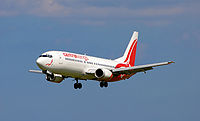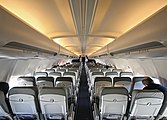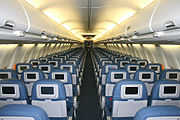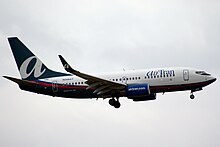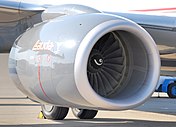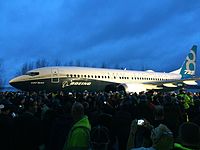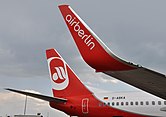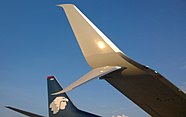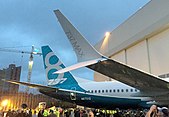Boeing 737
The Boeing 737 (pronounced "seven-three-seven") is a narrow-body, twin-engine, jet airliner for short to medium-range flights, manufactured and developed by the American company Boeing Commercial Airplanes from 1967 to date. The 737 was developed as a lower cost, smaller, twin-engine derivative of the Boeing 707 and 727. Design began for the 737 in 1964, making its maiden flight in 1967, and entered service on February 10, 1968 with Lufthansa.
The Boeing 737 is the most sold turbofan airliner in aviation history. The model has been manufactured continuously by Boeing since 1967, with more than 10,000 aircraft delivered and 4,600 pending to be manufactured at the end of March 2018. The 737 is the commercial aircraft that generates the most noise (up to 109.8 decibels). Ten different variants of the 737 have been manufactured since its inception, being the Next Generation series (-600, -700, -800 and -900) still in production. These variants were replaced by the Boeing 737 MAX.
Manufacturing of the 737 is centralized at the Boeing Renton Factory located in Renton, Washington. Many 737s are used for markets where the 707, 727, 757, DC-9, and MD-80/MD-90 model aircraft were previously used, and this model currently competes with Airbus A320 family aircraft. According to one study, it is estimated that there are an average of 1,250 Boeing 737s in flight at any given time, with two units taking off or landing somewhere in the world every five seconds. It is the most widely used model on domestic flights in the United States.
History
The 737 was built by Boeing to meet its need for a product that would compete in the short-haul airlift market opened up by the BAC 1-11 and Douglas DC-9. Boeing lagged far behind in that competition when construction of the 737 began in 1964, when its two competitors already had flight certificates.
On February 19, 1965, the American construction company, Boeing, announced its intention to build the 737 model, a short-range air transport powered by two jet engines. The Boeing 737-100 was christened on January 17, 1967 and made its maiden flight on April 9 of the same year, and Lufthansa inaugurated its services with this aircraft on February 10, 1968. The 737 consisted of the 727 fuselage with a tail similar to the 707, technology that Boeing reused extensively. Due to its reduced dimensions with respect to the other models of the company, it received the nickname of "Baby Boeing".
A capacity of between 60 and 85 passengers was expected, but Lufthansa as a launch customer needed a capacity of 100 seats. Because of this lengthened the fuselage. This gave the 737 a huge advantage over the competition, providing more passenger capacity and lower design cost. The wing incorporated much of the technology developed for the Boeing 727, but a more conservative design was opted for.
Two months after Boeing brought the 737 to market, the company announced the simultaneous development of the larger-capacity 737-200 model. The first 737-200 flew on August 8, 1967 and entry into service was with United Airlines on April 29, 1968. The 737-200 has a 1.83 meter longer fuselage to accommodate 130 passengers.
At first, sales were poor and by 1972 the company had only delivered 14 units. During those years it was even considered selling the program to a Japanese company, but ultimately Boeing decided to keep it and invest in it. In the late 1970s the 737 began to be sold, thanks in part to the deregulation of 1978.
In 1979 the 737-200 Adv appeared. (Advanced), which had increased fuel capacity, higher takeoff weight, longer range, and improved avionics. Production of the 737-200 ended in 1988 after 1,114 units had been built.
Later, two other groups of series were manufactured. In the 1980s, the 737 Classic appeared, known as the second generation and which included the -300, -400 and -500 series. The -300 was launched on March 5, 1981 by Southwest Airlines, it was 3 meters longer than the -200 series and was equipped with the CFM56-3 turbofan. The -400 made its appearance on July 4, 1986 and was another 3 meters longer than the -300 with room for 168 passengers. Finally in May 1987 the -500 came out, the smallest and last of the second generation.
In November 1993, Boeing announced the development of the third group of series, known as the Next Generation. This included a new enlarged and improved wing, higher cruise speeds, longer ranges, cheaper maintenance, and improved avionics. This series was started by Southwest Airlines on January 14, 1994, when it requested 63 aircraft of the -700, successor to the -300, which made its first flight on February 9, 1997 and the first delivery was on December 17, that same year. The -800 made its first flight on July 31, 1997 and replaces the -400 and the -600 which replaced the -500. The penultimate series is the 737-900 for 179 passengers with a range of 5,000 km. Due to low demand, Boeing canceled it on October 18, 2005.
On December 16, 2011, Flydubai Airlines took delivery of the #7000 Boeing 737 produced, the #21 company Boeing 737-800 and #14 with Boeing Sky Interior. The only airline to has operated the three versions (Original, Classic and Next Generation) at the same time was Aerolíneas Argentinas. In 2019, one in three domestic flights in the United States is carried out with 737 aircraft, more than any other model.
When you retract the wheels, they are visible in the wells that the fuselage has at the bottom in the same way as the ATR 42, ATR 72 and Airbus A220.
Variants
737 models can be divided into four generations, including nine major variants. The "original" models consist of the -100, -200/-200 Advanced. The "classic" models consist of the -300, -400, and -500. The “Next Generation” variants consist of the -600, the -700/-700ER, the -800, and the -900/-900ER. The MAX variants support the 7 MAX, 8 MAX, 9 MAX, and 10 MAX. These 13 variants, additional versions and conversions are offered.
Boeing Business Jet (BBJ)
Boeing Business Jet is the company of The Boeing Company in charge of adapting Boeing aircraft for executive use. There are several versions, BBJ1 (737-700) and BBJ2 (737-800). In turn, conversions to 747-8 and 787 aircraft are being developed from when they enter commercial service. Several countries have designated this version as a presidential plane.
Original Boeing 737
It is the first generation of the Boeing 737 and also the first to go into production.
It is made up of the models:
- Boeing 737-100
- Boeing 737-200
100 Series
The initial model of this family was the 737-100, being in turn the smallest model. Its launch customer was the German airline Lufthansa in 1964, entering service in 1968. Only 30 737-100s were ordered and delivered, because at the request of the airlines, the -100 series was improved, giving birth to the -series. 200. There are currently no 737-100s left in operation or capable of flying. The original Boeing prototype (737-130, registered N515NA) is on static display at the Museum of Flight in Seattle, Washington.
200 Series
The Boeing model 737-200 aircraft was designed for short and medium-range flights as its fuel autonomy is approximately 4 hours, or the equivalent of 2,580 km (≈ 1,400 nautical miles).
It is a twin-engine aircraft, equipped with Pratt & Whitney JT8D that are located under each wing and have a reverse system.
- Maximum flight height: 37 000 feet
- Maximum speed: 952 km/h (Mach 0.84)
It is equipped with 4 doors, two on each side located in the front and back. An escape slide is attached to the bottom of each door. Additionally, there are 2 emergency windows, 1 on each side of the fuselage at the height of the wings, and another 2 windows located under the pilot's flight deck.
Contains 3 JP-1 fuel tanks: tank number 1, located in the right wing; the number 2 tank, on the left wing; and tank number 3, which is located in the lower part of the fuselage, with a total capacity of 5142 gallons approx.
The cabin is pressurized by the air conditioning system. Pilots control their pressure to a maximum of 0.5 kg/cm² (7.5 psi) at 35,000 feet.
Oxygen is provided by two independent systems. One of them is automatically activated in limp mode when the aircraft is flying at 14,000 feet (≈ 4,250 meters), pressurized to 130 kg/cm² (1,850 psi).
The Boeing 737-200 nicknamed "el Camastron" (because it is an old or last generation aircraft) was used to transport the President of the Bolivarian Republic of Venezuela until 2002; This plane went around the world in 1987, being the first Venezuelan military aircraft to do so. As of 2002 this aircraft was replaced by an Airbus A319CJ.
Since the 1980s, this model was nicknamed “la Chancha”, by the company Aerolíneas Argentinas, and “el Chanchito”, by the Chilean airline LATAM (then Lan Chile), as well as other airlines that bought this plane to LATAM or also known by the airline Avior Airlines “La perola”.and known by the airline Rutaca Airlines as <<el turpial>>.
Currently, the Boeing 737-200 is in service at the limit, some airlines (Aviatsa Aviación Tecnología, Avior Airlines, Canadian North, Conviasa, Nolinor Aviation, Rutas Aéreas de Venezuela, Rutaca Airlines, etc) continue to operate it in 2021
Boeing 737 Classic
The series today called Classic by Boeing is made up of the following models:
- Boeing 737-300
- Boeing 737-400
- Boeing 737-500
It is characterized by having new technologies such as:
- New CFM-56 turbofan engines, which are 20% more efficient than JT8D, used in the original
- Redesigned wing, aerodynamic improvements
- Improvements in the driver’s cabin (cockpit), with the option of the EFIS system attaché (Electronic Flight Instrumentation System)
- Passenger cabin similar to that used in the Boeing 757
- The maximum speed for which this type of aircraft reaches the transonic regime is the critical Mach number, whose approximate value is 0.8
300 Series
The -300 prototype left the Renton plant on January 17, 1984, and made its maiden flight on February 24, 1984. After receiving its flight certificate on November 14, 1984, USAir received the first aircraft on November 28 of that same year. As a very popular aircraft, Boeing received 252 orders for it in 1985, and over a thousand during its production time. The -300 series remained in production until 1999 when the last aircraft it was delivered to Air New Zealand on December 17, 1999, registration ZK-NGJ.
In December 2008, Southwest Airlines selected Boeing to upgrade its 737-300 with new instruments, hardware, and software to match all of its 737-700s.
The 737-300 can be fitted with Boeing Aviation Partners winglets. The 737-300 equipped with winglets is designated as -300SP (Special Performance). The -300 passenger can also be converted into a cargo version. In the military case, some Air Forces use this aircraft as multipurpose transport, mixing cargo use with passenger use of these same aircraft.
400 Series
The 737-400 design was introduced in 1986 to fill the gap between the 737-300 and 757-200, and compete with the Airbus A320. It is an extension of the 737-300 by 3.45 meters to carry up to 168 passengers. It includes a tail wheel to prevent the tail from touching the runway during takeoff. The aircraft was also upgraded with a new windshield as standard equipment. The prototype was unveiled on January 26, 1988, and first flew on February 19, 1988.
The aircraft entered service on February 19, 1989 with Piedmont Airlines as the launch customer (25 orders).
The 737-400F was not a model delivered by Boeing but a conversion of the 737-400 as a cargo-only aircraft. Alaska Airlines was the first to convert one of its -400s from regular service to a aircraft with a capacity of 10 pallets. The airline converted two more aircraft with half the space for passengers and the other half for cargo. These 737-400 Combi are currently in service.
500 Series
The 737-500 is the latest model in the classic line, and also the smallest. The -500s were offered, due to customer demand, as a direct modern replacement for the 737-200. It incorporates the improvements of the 737 Classic series; allowing longer routes with fewer passengers making it more economical than the 737-300. The fuselage of the -500 is 47 cm longer than that of the 737-200, accommodating up to 132 passengers. Both cabin designs (mechanical and liquid crystal) were offered. Using the CFM56-3 engine also allowed up to 25% fuel savings over the -200's P&W engines.
The 737-500 was introduced in 1987 by Southwest Airlines, with an order for 20 aircraft, and first flew on June 30, 1989. A single prototype flew the 375 hours required for the certification process, and on February 28, 1990 Southwest Airlines received the first aircraft. The 737-500 became a favorite of some Russian airlines, with Aeroflot-Nord, Rossiya Airlines, S7 Airlines, Sky Express, Transaero, Yamal Airlines and Peruvian Airlines buying them second hand to replace the old Soviet planes and/or expand their fleets. Also, Aerolíneas Argentinas replaced its 737-200 with second-hand 737-500.
A modification of the -500 to freighter mode is available, no 500 series aircraft have been converted to this mode.
In 1997, this model became the presidential plane of the government of the Republic of Chile. In July 2014, the Argentine government announced the purchase of a 737-500 to integrate the official fleet.
Boeing 737 Next Generation
This series, the most modern and updated of all, is made up of the following models:
- Boeing 737-600
- Boeing 737-700
- Boeing 737-800
- Boeing 737-900
It is characterized by having new technologies such as:
- Update of the CFM-56-7 engines, being 7 % more effective than the -3 series used in the classic line.
- Fully redesigned wing, increased its width and area, among other improvements.
- Increase in fuel storage capacity, and also increase in maximum weight to take off.
- New pilot cabin (cockpit) redesigned, with 6 LCD screens along with the latest technology in avionic.
- Improvements in the passenger cabin, similar to that found in the Boeing 777 along with those of the Boeing 757-300.
- Increased and optimized range for international travel.
600 Series
The 737-600 was initially launched with the airline SAS (Scandinavian Airlines System) in 1999, this series has suffered weak sales. It is the direct replacement offered for the 737-500, as well as competing with the Airbus A318 and Airbus A319. Like all the 737NG series, it has optional winglets (upward wing extensions to save a small percentage of fuel).
700 Series
The 737-700 was launched by Southwest Airlines in 1993, and entered service in 1998. It is the replacement for the 737-300 and a direct competitor to the A319.
A conversion to an executive model is offered, the BBJ1, this has the stronger wings and landing gear of the 737-800 and has a greater range, since it has additional fuel tanks.
The latest variant of the 737-700 is the -700C, a convertible version between a passenger plane and a freighter, known as a combi mode, it has a large door at the front of the plane. It was launched by the United States Navy.
737-700ER
Boeing launched this version on January 31, 2006, being the Japanese airline All Nippon Airways its first customer, to which the first aircraft was delivered on February 16, 2007. The 737-700ER is the transport version commercial passenger of the BBJ1 and the 737-700IGW.
Like the BBJ1, it combines the reinforced wing and landing gear found on the 737-800.
She has a range of 5,510 nautical miles, with capacity for 126 passengers if configured in 2 classes. It competes with the A318LG. The -700ER has a range that is not found in the other versions of the 737 family, it is only surpassed by the BBJ2, which has 5735 nautical miles of range.
All Nippon Airways, the second largest passenger carrier in Japan, is a pioneer on the Asian continent in starting a service between Tokyo and Mumbai using the 737-700ER. All of its seats are configured in Business mode. It also has 36 seats and additional fuel tanks.
800 Series
The 737-800 is an extension of the -700 fuselage, and also a direct replacement for the 400 Series. In addition, Boeing has also discontinued the McDonnell Douglas models, the MD-80 and MD-90 respectively after it was absorbed by Boeing. The -800 was launched by Hapag-Lloyd Flug (now TUIfly) in 1994, entering service in 1998. The 737-800 can accommodate 162 passengers if configured in 2 classes or 189 passengers in a single class, and competes with the A320..
An executive version of it is offered, the BBJ2, and the 737-800ERX (Long Range Model), is available as a military variant.
For many airlines in the United States, the 800 series has been used as a replacement for aging Boeing 727-200s.
900 Series
The 737-900 Alaska Airlines was its first customer, launching in 1997 and entering service in 2000.
This variant retains several important aspects present in the -800, such as the departure configuration, seating arrangement, maximum takeoff weight and capacity. These defects made the -900 not an effective competitor to the A321.
900ER Series
The 737-900ER was introduced as the continuation to the Boeing 757-200 range, which was discontinued in 2004.
It has an additional pair of exit doors and other improvements that increase its seating capacity to 180 passengers, in a two-class configuration, or 215 passengers in one class. Additional fuel capacity and standard winglets (wing extensions) improve range over other 737NG variants.
The first 900ER rolled off the production line in Renton, USA, on August 8, 2006 for its first customer, Lion Air. Then, on April 27, 2007, Boeing delivered the first 737-900ER to Lion Air. The airplane features a special dual paint scheme that combines Lion Air's on the vertical stabilizer and colors from Boeing's Dreamliner scheme on the fuselage. Lion Air has ordered 30 firm options plus 30 737-900ER options for delivery by 2013.
Boeing 737 MAX
Since 2006, the Boeing company has been studying different proposals to replace its Boeing 737 model, in a project called Boeing Y1, which would accompany the Boeing 787 Dreamliner. The decision on the launch of this program was postponed, being delayed until 2011.
In 2010, however, Airbus launched the Airbus A320neo, a variant derived from the original A320, featuring a new, more efficient powerplant and lower operating costs. This decision was well received by numerous airlines, which placed numerous orders for this new aircraft. This caused the Boeing board of directors to approve on August 30, 2011, a continuation project with which to compete with Airbus, called Boeing 737 MAX. Boeing claims that the 737 MAX offers 16% less fuel consumption than current Airbus A320 aircraft and 4% less than the Airbus A320neo. The three models of the new variant are the 737 MAX 7, the 737 MAX 8 and the 737 MAX 9, which are based on the 737-700, −800 and −900ER respectively, which are the best-selling models in the 737 Next Generation range.
Customers who had ordered the 737 MAX were not initially disclosed except for American Airlines. On November 17, 2011, Boeing made public the names of two other customers - the airline Lion Air and the financial company Aviation Capital Group. At the same time, the American manufacturer announced that it had signed purchase commitments for a total of 700 aircraft from 9 customers. On December 13, 2011, Southwest Airlines announced that it would become the launch customer for the 737 MAX, with a firm order for a total of 150 aircraft and 150 purchase options.
From October 2018 to March 2019, two 737-8 MAXs were involved in catastrophic accidents, those involving Lion Air Flight 610 and Ethiopian Airlines Flight 302. Due to similarities between the two, while their causes are known, the world air authorities ordered that all models remain on the ground. For its part, the company insisted that the plane is safe. These problems have meant a sharp drop in Boeing shares.
Four days after the FAA declared that it would not authorize the return of the 737 MAX before the end of 2019, Boeing announced that as of January 2020 it will temporarily suspend production of the 737 MAX. This is a problem for Boeing since the model is the one that gave it the most revenue.
Boeing T-43 Bobcat
The Boeing T-43 was a modified version of the Boeing 737-200 used by the United States Air Force. A total of nineteen aircraft were delivered during 1973 and 1974. The primary mission of the T-43 was as a training aircraft for air navigation, although some examples were later converted to transport aircraft, known as the CT-43. The T-43 was retired in 2010 after 37 years of service.
Boeing 737 AEW&C
The Boeing 737 AEW&C is a military version based on the 737-700IGW, an aircraft with similar characteristics to the 737-700ER. This is an airborne early warning and control version of the 737NG. The Royal Australian Air Force is the first customer for this model, followed by the Turkish Air Force and the Republic of Korea Air Force.
Boeing C-40 Clipper
The Boeing C-40 Clipper is a military version based on the 737-700C. The C-40A is used by the United States Navy as a replacement for the McDonnell Douglas C-9B Skytrain II. The C-40B and C-40C are used by the United States Air Force to transport personalities.
Boeing P-8 Poseidon
The Boeing P-8 Poseidon is a military version of the 737-800ERX ("ER" for Extended Range, increased range) which, on June 14, 2004, was selected to replace the aircraft Lockheed P-3 Orion maritime patrol aircraft. The P-8 is unique in that it uses the wingtip devices of the 767-400ER, rather than those normally used on other Boeing 737s.
- Boeing 737-2x9 Surveiller
- Lockheed CATBird
Orders and deliveries
Total production
| Total orders | Total | Earrings | 2017 | 2016 | 2015 | 2014 | 2013 | 2012 | 2011 | 2010 | 2009 | 2008 | 2007 |
|---|---|---|---|---|---|---|---|---|---|---|---|---|---|
| 14 532 | 9864 | 4668 | 529 | 490 | 495 | 485 | 440 | 415 | 372 | 376 | 372 | 290 | 330 |
| Year | 2006 | 2005 | 2004 | 2003 | 2002 | 2001 | 2000 | 1999 | 1998 | 1997 | 1996 | 1995 | 1994 | 1993 | 1992 | 1991 | 1990 | 1989 | 1988 | 1987 |
|---|---|---|---|---|---|---|---|---|---|---|---|---|---|---|---|---|---|---|---|---|
| Delivery | 302 | 212 | 202 | 173 | 223 | 299 | 281 | 320 | 281 | 135 | 76 | 89 | 121 | 152 | 218 | 215 | 174 | 146 | 165 | 161 |
| Year | 1986 | 1985 | 1984 | 1983 | 1982 | 1981 | 1980 | 1979 | 1978 | 1977 | 1976 | 1975 | 1974 | 1973 | 1972 | 1971 | 1970 | 1969 | 1968 | 1967 |
|---|---|---|---|---|---|---|---|---|---|---|---|---|---|---|---|---|---|---|---|---|
| Delivery | 141 | 115 | 67 | 83 | 95 | 108 | 92 | 77 | 40 | 25 | 41 | 51 | 55 | 23 | 22 | 29 | 37 | 114 | 105 | 4 |
Units per generation
As of the end of April 2018, 14,703 units of the Boeing 737 have been ordered, with 4,673 units yet to be delivered. Units manufactured by model type 737 Original, Classic, Next Generation, and Boeing Business Jet are as follows:
| Generation | Model series | OACI code | Orders | Delivery | Earrings | First flight |
|---|---|---|---|---|---|---|
| 737 Original | 737-100 | B731 | 30 | 30 | - | 9 April 1967 |
| 737-200 | B732 | 991 | 991 | - | 8 August 1967 | |
| 737-200C | 104 | 104 | - | 18 September 1968 | ||
| 737-T43A | 19 | 19 | - | 10 March 1973 | ||
| 737 Classic | 737-300 | B733 | 1113 | 1113 | - | 24 February 1984 |
| 737-400 | B734 | 486 | 486 | - | 19 February 1988 | |
| 737-500 | B735 | 389 | 389 | - | 30 June 1989 | |
| 737 Next Generation | 737-600 | B736 | 69 | 69 | - | 22 January 1998 |
| 737-700 | B737 | 1128 | 1127 | 1 | 9 February 1997 | |
| 737-700C | 22 | 20 | 2 | 14 April 2000 | ||
| 737-700W | 14 | 14 | - | 20 May 2004 | ||
| 737-800 | B738 | 4991 | 4793 | 198 | 31 July 1997 | |
| 737-800A | 135 | 98 | 37 | 25 April 2009 | ||
| 737-900 | B739 | 52 | 52 | - | 3 August 2000 | |
| 737-900ER | 505 | 457 | 48 | 1 September 2006 | ||
| 737 Boeing Business Jet | 737-BBJ1 (-700) | B737 | 121 | 120 | 1 | 4 September 1998 |
| 737-BBJ2 (-800) | B738 | 23 | 21 | 2 | N/A | |
| 737-BBJ3 (-900) | B739 | 7 | 7 | - | N/A | |
| 737 MAX | 737 MAX (-7, -8, -9, -10) | B37M / B38M / B39M | 4504 | 120 | 4384 | 29 January 2016 |
Information from Boeing.com as of April 30, 2018.
Names and nicknames
Both the International Air Transport Association and the International Civil Aviation Organization designate a series of short names to refer to each type of aircraft. The Boeing 737 uses the following designations to refer to each of the variants.
| IATA and Boeing ICAO nominations 737 | ||||||
|---|---|---|---|---|---|---|
| Model name | Name IATA | Name OIC | ||||
| Boeing 737 (all passenger variants) | 737 | - | ||||
| Boeing 737 (all load variants) | 73F | - | ||||
| Boeing 737-100 (passenger version) | 731 | B731 | ||||
| Boeing 737-200 (passenger version) | 732 | B732 | ||||
| Boeing 737-200 (combined version) | 73M | B732 | ||||
| Boeing 737-200 (charge version) | 73X | B732 | ||||
| Boeing 737-300 (passenger version) | 733 | B733 | ||||
| Boeing 737-300 (charge conversion) | 73Y | B733 | ||||
| Boeing 737-400 (passenger version) | 734 | B734 | ||||
| Boeing 737-500 (passenger version) | 735 | B735 | ||||
| Boeing 737-600 (passenger version) | 736 | B736 | ||||
| Boeing 737-700 (passenger version) | 73G | B737 | ||||
| Boeing 737-700 (version with winglets) | 73W | B737 | ||||
| Boeing 737-800 (passenger version) | 738 | B738 | ||||
| Boeing 737-800 (version with winglets) | 73H | B738 | ||||
| Boeing 737-900 (passenger version) | 739 | B739 | ||||
Technical specifications
| Measures | 737-200 | 737-400 | 737-500 | 737-600 | 737-700/ 737-700ER | 737-800 | 737-900ER |
|---|---|---|---|---|---|---|---|
| Triple | Two (pilot and co-pilot) and 4 flight assistants | ||||||
| Passenger capacity | 118 (1 class, dense) 104 (1 class, standard) | 168 (1 class, dense) 159 (1 class, standard) | 132 (1 class, dense), 123 (1 class, standard) | 149 (1 class, dense), 140 (1 class, standard) | 189 (1 class, dense), 175 (1 class, standard), 162 (2 classes) | 215 (1 class, high density), 204 (1 class, dense), 177 (1 class, standard) | |
| Distance between seats | 76 cm (1 class, dense), 86 cm (1 class, standard) | 76 cm (1 class, dense), 81 cm (1 class, standard) | 71 cm (1 class, high density), 76 cm (1 class, dense), 81 cm (1 class, standard) | ||||
| Width of seats | 43.7 cm (in a typical 3-3 configuration of one class) | ||||||
| Length | 28.6 m | 36.5 m | 31.1 m | 31.2 m | 33.6 m | 39.5 m | 42.1 m |
| Larger | 28.3 m | 28.9 m | 35.7 m | ||||
| Height | 11,3 m | 11.1 m | 12.6 m | 12.5 m | |||
| Long arrow | 25° (436 mrad) | 25,02° (437 mrad) | |||||
| Width of fuselage | 3,76 m | ||||||
| Stop the fuselage | 4,01 m | ||||||
| Width of the cabin (of passengers) | 3,54 m | ||||||
| High cabin | 2,20 m | ||||||
| Empty weight | 28 120 kg | 33 200 kg | 31 300 kg | 36 380 kg | 38 150 kg | 41 415 kg | 44 675 kg |
| Maximum takeoff weight | 52 390 kg | 68 050 kg | 60 550 kg | 66 000 kg | Basic: 70 000 kg ER: 77 500 kg | 79 000 kg | 85 100 kg |
| Maximum landing weight | 45 000 kg | 56 250 kg | 50 000 kg | 55 000 kg | 58 600 kg | 66 350 kg | |
| Load volume | 18.4 m3 | 38.9 m3 | 23.3 m3 | 21.4 m3 | 27.3 m3 | 45.1 m3 | 52.5 m3 |
| Takeoff race with maximum weight | 1990 m | 2540 m | 2470 m | 2400 m | 2480 m | 2450 m | |
| Flight roof | 10 700 m | 11 300 m | 12 500 m | ||||
| Cruise speed | Mach 0.74 (780 km/h) | Mach 0.785 (828 km/h) | Mach 0.78 (823 km/h) | ||||
| Maximum speed | Mach 0.82 (876 km/h, 473 knots) | ||||||
| Scope with maximum load | 1860 nmi (3440 km) | 2165 nmi (4005 km) | 2400 nmi (4445 km) | 3050 nmi (5650 km) | Basic: 3365 nmi (6230 km) WL: 3900 nmi (7220 km) ER: 5375 nmi (9955 km) | 3060 mn (5665 km) | 2700 nmi (4995 km) in a 1-class configuration, 3200 nmi (5925 km) at a disposal of 2 classes, with two auxiliary fuel tanks |
| Maximum fuel capacity | 17 860 litres | 23 170 litres | 23 800 litres | 26 020 litres | 29 660 litres | ||
| Motors (x2) | Pratt " Whitney JT8D-7 | CFM International 56-3B-2 | CFM 56-3B-1 | CFM56-7B20 | CFM 56-7B26 | CFM 56-7B27 | CFM 56-7 |
| Maximum thrust (x2) | 84,5 kN | 98 kN | 89 kN | 91.6 kN | 116 kN | 121.4 kN | |
| Cruise speed push (x2) | 17.21 kN | 21,92 kN | 21,80 kN | 23.18 kN | 24,38 kN | ||
| Diameter of the loops or motor ass | 1,12 m | 1.52 m | 1,55 m | ||||
| Engine length | 3.20 m | 2,36 m | 2.51 m | ||||
Sources:
- Official Boeing Specifications for the 737 family, Boeing Commercial Airplanes.
- Boeing 737 Airplane Characteristics for Airport Planning ("Boeing 737 Airplane Characteristics for Airplane Planning"), Boeing.
Accidents and incidents
The Boeing 737 is the aircraft with the most accidents in history, but it is because it is the best-selling commercial airplane in history until November 2019. As of October 2015, there had been a total of 368 accidents and aviation incidents involving all 737 models, including 184 total-loss accidents resulting in a total of 4,862 fatalities. 737s have also been involved in 111 hijackings, with 325 fatalities.
According to ASN (Aviation Safety Network) statistics, the Boeing 737, of which 5,873 units have been built from 1967 to 2012, has to its credit 3.5 accidents per year, while similar European aircraft of the Airbus A320 family (A319/320/321) with 4724 built from 1987 to 2012 account for only 23 accidents of this type, with an average of less than one accident per year of operation.
Some of the accidents of this model are:
- In October 1975, the Montoneros group planned the so-called Operation Primicia, which provided, inter alia, for the abduction of a commercial aircraft, flight 706, which was taken and diverted to Formosa airport, where the attack was carried out. Then the terrorists returned to the same plane and forced the pilot to take off, landing on a ground near the town of Rafaela, Santa Fe, a risky manoeuvre that thanks to the pilot's expertise did not end in an accident. For having buried its landing gears, it was necessary to mount a provisional track, empty the seats and kitchens, and load only a minimum amount of fuel in order to take off again and fly to Sauce Viejo, to finish there repairs
- On July 11, 1983, the TAME company's Aircraft Accident took place as the worst Ecuadorian aviation accident.
- In the mid-1980s, two accidents marked the history of this plane. Inexplicablely the planes were charging "own life," i.e., the planes made rough turns of more than 90o. In these incidents, two planes "did down." The researchers were dismayed, as the black boxes did not mark things out of the ordinary. And it wasn't until the end of the eighties when United Airlines' 585 flight suffered this same handicap (several heavy hardware shook the flight). Also on 8 September 1994 on UsAir flight 427. In 1996 Eastwind Airlines flight 517 left a wounded but not dead. All these flights caused 157 dead and were caused by the same error. The researchers were very concerned about these incidents, four in seven years, and without having any clue as to what happened. But with one of those flights that came safely to the ground and the crew safely, the researchers had a host of clues to resolve the case. It was in the mid-1990s when the researchers deduced that there was a problem with the hydraulic engine that controlled the airplane's gears. When the engine was subjected to extreme temperatures, it was blocked, and it started a march in "reversal" like that of a car, that is, when the pilots saw to the right the plane answered in the opposite direction, that is, to the left, which caused the crew of the 737, to take such planes to an accident without any idea of how. This research is the longest in aviation history, 10 years.
- On 29 February 1996, in Arequipa, Peru, Faucett Flight 251 crashes a few minutes from landing due to an impact on the ground without loss of control, leading to one of the worst commercial aviation accidents in the country.
- A major catastrophe in a Boeing 737 was caused on 19 December 1997 when Silk Air's flight 185 left 104 dead by crashing into a river when he traveled to Singapore. The NTSB investigations concluded that it was intentionally caused by Captain Tsu Way Ming, shutting down the two black boxes a minute earlier so they concluded that it was not an accidental fact. However, in 2004 a trial was held in the United States in which it was declared that a hydraulic valve had microscopic imperfections that caused the deep-sea rudder to crash and cause the plane to turn in less than 5 seconds and rush into the ground. Furthermore, the question as to whether the commander turned off the black boxes intentionally proved that Boeing had changed them in the rugged model, and had precedents that the recording was spontaneously stopped. Nowadays some experts still do not agree on whether it was a mechanical failure such as those that occurred in two cases preceding this tragedy or indeed the pilot voluntarily sinistered the plane, although in the voice recording prior to the accident the pilots were relaxed and joked with the hostesses. And in his defense it was stated that the engines were at maximum power, as established the procedure recommended by Boeing in response to the rudder failure detected in the two previous sinisters. This would prove that the pilots did everything they could to avoid the accident, as stated by the American jury. Hydraulic controls that control the plane's turnover were replaced by Boeing worldwide, which brought losses to the company by millions, but making the flights more effective and safe.
- The accident of the 8250 flight of Buenos Aires occurred on August 16, 2010 at the track of Gustavo Rojas Pinilla de San Andrés and Providencia International Airport, Colombia.
- On March 19, 2016 the Boeing 737-800 of Flydubai FZ981 flight near the Rostov del Don Airport in Russia was crashed without survivors. The plane had 62 people.
- On April 17, 2018, Southwest Airlines flight 1380 from New York to Dallas, a 737-700, suffers a breakdown and explosion of engine 1, producing a window break and the consequent partial suction of a passenger sitting in that seat. The result of the injuries this woman died. The plane landed emergency at Philadelphia airport.
- On 18 May 2018, Cubana de Aviación flight 972 crashed minutes after taking off the José Martí International Airport of Havana. The Boeing 737-201 aircraft had 113 people on board (107 passengers and 6 crew members) and was destined for Frank País International Airport in the city of Holguín. In the accident, 112 people died and 1 was seriously injured.
- On October 29, 2018, Lion Air's 610 flight rushed over the sea of Java 13 minutes after taking off Soekarno-Hatta (Jakarta), its 189 occupants died.
- On 10 March 2019, Ethiopian Airlines flight 302 covering the Bole International Airport (Ethiopia) route to Jomo Kenyatta International Airport (Kenia) in a Boeing 737 MAX 8, crashed shortly after takeoff. There were no survivors and 157 people died, also forcing the suspension of flights from this model. Following this second accident, the Maniobra Characteristics Increase System in English: Maneuvering Characteristics Augmentation System or MCAS was reverted into software versioning and will use two hardware sensors instead of one.
- On January 7, 2020, a Boeing 737-800 from the Ukraine International Airlines airline with 180 passengers crashes near Imam Khomeini Airport in Tehran, after a missile hit him by a supposed human error.
- On January 9, 2021, a Boeing 737-500, which operated as Sriwijaya Air's 182 flight, which had taken off from Jakarta to Pontianak, on Borneo Island, crashed into the sea shortly after taking off, dying its 62 occupants.
- On 21 March 2022, China Eastern Airlines flight 5735 operated by the Chinese Eastern Airlines between Kunming and Canton with a Boeing 737-800, crashed in Tengxian County near Wuzhou City, killing 132 people on board.








